Wagashi
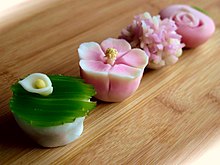 Nerikiri ( | |
| Type | Confectionery |
|---|---|
| Place of origin | Japan |
Wagashi (
Most of today's wagashi were born during the Edo period (1603–1868). This was a period of peace, economic and cultural prosperity, and increased domestic self-sufficiency in sugar.[2][3][4]
During the Edo period, a series of delicate and beautiful fresh wagashi called nerikiri (
Definition
[edit]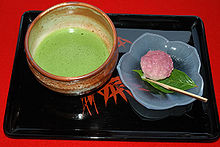
In Japan, the word for sweets or confectionery, kashi (
In 1603, the first year of the Edo period (1603–1868), the term kashi (
The word wagashi was coined at the end of 1800s to distinguish Japanese confectionery from sweets, cakes and baked goods introduced from the West termed yōgashi (
The definition of wagashi is ambiguous, and the line between wagashi and other types of Japanese confectionery is vague. For example, although the original kasutera (castella) was introduced from Portugal, it has been around for more than 400 years and has been modified to suit Japanese tastes, so it is classified as a wagashi.[9][3][4] Mizu shingen mochi (
History
[edit]Before the Edo period
[edit]Jomon - Nara period
[edit]It is believed that the first food eaten as a confection in Japan was a processed food from the Jomon period.[2] It is thought to have been either a food made by kneading chestnuts into a powder and then baking and hardening it with eggs and salt, or a food made by adding animal flesh to chestnut flour and baking and hardening it.[13]
During the Yayoi period, dango (

During the Nara period (710–794), a food called karakudamono (
Heian - Muromachi period
[edit]The first beautifully crafted confections were created in the Heian period (794–1185) and are mentioned in The Tale of Genji under the names tsubakimochi (
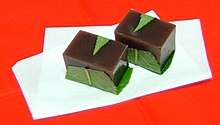
During the Kamakura period (1185–1333), Japanese Buddhist monks who studied in the Song dynasty brought the tea culture to Japan, and the custom of eating confections with tea began in Japan.
The monks also introduced tenshin (
Sengoku and Azuchi-Momoyama period
[edit]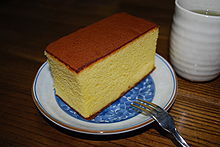
During the Sengoku period, the Portuguese brought Western confectionery to Japan through the Nanban trade. Kasutera (カステラ, castella) is a typical confection based on these Western confections. Kasutera was the only exception because it was made from chicken eggs, while Japanese confectionery was made from vegetable ingredients.[3][4] To suit their own tastes, the Japanese added mizuame (
From the Sengoku period to the Azuchi-Momoyama period, wagashi developed along with the Japanese tea ceremony, and delicate, beautiful, and aesthetically pleasing confections began to emerge. The Japanese tea ceremony was used as a secret meeting place for daimyō (
Emergence of modern wagashi
[edit]
During the Edo period, wagashi developed dramatically, establishing what we know today as wagashi.[2][4] From the Keicho (1596–1615) to the Kan'ei era (1624–1644), classical Japanese literature and seasonal elegance began to be incorporated into wagashi brand names. During the Genroku era (1688–1704), when the Genroku culture flourished, wagashi with beautiful shapes and colors based on themes from classical literature and seasonal elegance began to be produced under the influence of the Rimpa school of art.[3]
Self-sufficiency in sugar increased when Tokugawa Yoshimune, the eighth Tokugawa shogun, encouraged the production of sugar.[2] In Sanuki Province, which is now Kagawa Prefecture, sugar called wasanbon (
The famous Kyoto wagashi Yatsuhashi (
Ame and amezaiku
[edit]
During this time, ame (
The production of amezaiku (
Japan's modernization and beyond
[edit]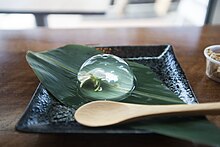
During the Meiji era (1868–1912), when Japan began active trade with the West after the end of its sakoku (
In the 21st century, wagashi continues to be created. Nama yatsuhashi (
In 2014, a wagashi shop in Yamanashi Prefecture created a mizu shingen mochi (
Types
[edit]


- Akumaki: one of the confections of Kagoshima Prefecture
- Anmitsu: chilled agar jelly cubes (kanten) served with sweet red bean paste and fruit
- Amanattō: simmered azuki beans or other beans with sugar, and dried—amanattō and nattō are not related, although the names are similar.
- Botamochi: a sweet rice ball wrapped with anko (or an, thick azuki bean paste)
- Daifuku: general term for mochi (pounded sweet rice) stuffed with anko
- Dango: a small, sticky, sweet Japanese dumpling, commonly skewered on a stick
- Domyoji: wagashi made with anko (red beans) wrapped in sticky rice
- Dorayaki: a round, flat sweet consisting of castella wrapped around anko
- Gokabou: a sweetened cake made of rice and mixed with sugar
- Hanabiramochi: a flat, red and white, sweet mochi wrapped around anko and a strip of candied gobo (burdock), shaped like a flower petal
- Ikinari dango: a steamed bun with a chunk of sweet potato and anko in the center, it is a local confectionery in Kumamoto.
- Imagawayaki (also kaitenyaki): anko surrounded in a disc of fried dough covering
- Kompeito: crystal sugar candy
- Kusa mochi: "grass" mochi, a sweet mochi infused with Japanese mugwort (yomogi), surrounding a center of anko
- Kuzumochi
- Kuri kinton: a sweetened mixture of boiled and mashed chestnuts
- Manjū: steamed cakes of an surrounded by a flour mixture, available in many shapes such as peaches, rabbits, and matsutake (
松茸 ) mushrooms - Mochi: a rice cake made of glutinous rice
- Monaka: a center of anko sandwiched between two delicate and crispy sweet rice crackers
- Oshiruko (also zenzai): a hot dessert made from anko in a liquid, soup form, with small mochi floating in it
- Rakugan: a small, very solid and sweet cake which is made of rice flour and mizuame
- Sakuramochi: a rice cake filled with anko and wrapped in a pickled cherry leaf
- Taiyaki: like a imagawayaki, a core of anko surrounded by a fried dough covering, but shaped like a fish
- Uirō: a steamed cake made of rice flour and sugar, similar to mochi
- Warabimochi: traditionally made from warabi and served with kinako and kuromitsu
- Yatsuhashi: thin sheets of gyūhi (sweetened mochi), available in different flavors, like cinnamon, and occasionally folded in a triangle around a ball of red anko
- Yōkan: one of the oldest wagashi, a solid block of anko, hardened with agar and additional sugar
- Yubeshi
Classification
[edit]There are several ways to classify wagashi, including classification by moisture content, ingredients, and production method. The most common classification method is based on moisture content, which is very important because it affects shelf life. According to this classification, sweets with a moisture content of 30% or more are classified as namagashi (wet confectionery), those with a moisture content of 10% to 30% are classified as han namagashi (half-wet confectionery), and those with a moisture content of less than 10% are classified as higashi (dry confectionery).[9][25]
When classified by production method, each type of wagashi is classified as neri mono, which is made by kneading ingredients; mushi mono, which is made by steaming; yaki mono, which is made by baking; age mono, which is made by frying; nagashi mono, which is made by pouring ingredients into a mold; uchi mono, which is made by mixing powdered ingredients and sugar into a mold and then hardening the mixture; kake mono, which is made by pouring syrup over the ingredients; and ame mono, which is made by boiling down the sugar and hardening it, and so on.[9][25]
For example, yōkan can be classified as either namagashi (wet confectionery) or han namagashi (half-wet confectionery), depending on the product, as the moisture content varies from product to product. It is also classified as nagashi mono because it is made by pouring kanten (agar) into a mold and hardening it.[9][25]
- Namagashi (
生菓子 ) (wet confectionery)—contains 30% or more moisture- Jō namagashi (
上生 菓子 ) is a very soft and delicate, seasonally varying namagashi, in various, often elaborate, shapes and colors, often reflecting seasonal plants. Some stores will have many dozens over the course of a year.[26] - Mochi mono (もち
物 ) - Mushi mono (
蒸 し物 ) (steamed confectionery) - Yaki mono (
焼 き物 ) (baked confectionery)- Hiranabe mono (
平 なべ物 )(Flat pan baked confectionery) - Ōbun mono (オーブン
物 ) (oven baked confectionery)
- Hiranabe mono (
- Nagashi mono (
流 し物 ) - Neri mono (
練 り物 ) - Age mono (
揚 げ物 ) (fried confectionery)
- Jō namagashi (
- Han namagashi (
半生 菓子 ) (half-wet confectionery)—contains 10%–30% moisture- An mono (あん
物 ) - Oka mono (おか
物 ) - Yaki mono (
焼 き物 ) (baked confectionery)- Hiranabe mono (
平 なべ物 )(Flat pan baked confectionery) - Ōbun mono (オーブン
物 ) (oven baked confectionery)
- Hiranabe mono (
- Nagashi mono (
流 し物 ) - Neri mono (
練 り物 )
- An mono (あん
- Higashi (
干菓子 ) (dry confectionery)—contains 10% or less moisture- Uchi mono (
打 ち物 ) - Oshi mono (
押 し物 ) - Kake mono (
掛 け物 ) - Yaki mono (
焼 き物 ) (baked confectionery) - Ame mono (あめ
物 ) (candy confectionery)
- Uchi mono (
See also
[edit]- Chinese desserts – Chinese confections
- Hangwa – Korean confections
- Bánh – Vietnamese sweet or savoury snacks and confections
- Turkish delight – Turkish confections
- List of Japanese desserts and sweets
- List of Japanese snacks
References
[edit]- ^ Harrison, Thom (2021). "What is 'Wagashi'?". Wagashi UK. Retrieved 25 April 2023.
- ^ a b c d e f g h i j
和菓子 の歴史 (in Japanese). Ministry of Agriculture, Forestry and Fisheries (Japan). Archived from the original on 22 February 2024. Retrieved 22 February 2024. - ^ a b c d e f g h i j k l m
駆 け足 でたどる和菓子 の歴史 (in Japanese). National Diet Library. Archived from the original on 22 February 2024. Retrieved 22 February 2024. - ^ a b c d e f g h i j その1
和菓子 の歴史 (in Japanese). Japan Wagashi Association. Archived from the original on 22 February 2024. Retrieved 22 February 2024. - ^
練 り切 り (in Japanese). Digitalio, Inc. Archived from the original on 4 March 2016. Retrieved 23 February 2024. - ^ Ashkenazi, Michael (2000). The Essence of Japanese Cuisine: An Essay on Food and Culture. University of Pennsylvania Press. pp. 106–107. ISBN 9780812235661. Retrieved Jan 30, 2013.
- ^ a b c Darra Goldstein, ed. (2015). The Oxford Companion to Sugar and Sweets. Oxford University Press. pp. 776–777. ISBN 9780199313396.
- ^ Kie, Laure (2023). Sweet and Easy Japanese Desserts. Tuttle Publishing. p. 37. ISBN 9781462924394.
- ^ a b c d その2
和菓子 の種類 (in Japanese). Japan Wagashi Association. Archived from the original on 16 February 2024. Retrieved 22 February 2024. - ^ a b "
賞味 期限 がたったの30分 !山梨 でしか味 わえない絶品 「水 信玄 餅 」は事前 準備 をしっかりして挑 むべし!". Rocket news 24. 23 June 2021. Archived from the original on 28 February 2023. Retrieved 23 February 2024. - ^ "「ネオ
和菓子 」脚光 、小豆 高騰 ". The Nikkei. 27 April 2023. Archived from the original on 26 April 2023. Retrieved 24 February 2024. - ^
縄文 時代 にクッキーがつくられていた?縄文 クッキーの謎 (in Japanese). Nippon Broadcasting System. 8 April 2018. Archived from the original on 8 July 2023. Retrieved 22 February 2024. - ^ a b
羊羹 の歴史 について (in Japanese). Kaiundo. 28 January 2019. Archived from the original on 23 February 2024. Retrieved 22 February 2024. - ^
寒天 (in Japanese). Digitalio, Inc. 8 April 2018. Archived from the original on 23 February 2024. Retrieved 22 February 2024. - ^ うどんとうんどん (in Japanese).
日本 麺類 業 団体 連合 会 /全国 麺類 生活 衛生 同業 組合 連合 会 . 8 April 2018. Archived from the original on 22 December 2022. Retrieved 24 February 2024. - ^
日本 遺産 (Japan heritage) (PDF) (in Japanese). Nagasaki Prefecture. Archived from the original (PDF) on 23 February 2024. Retrieved 23 February 2024. - ^ シュガーロードの
砂糖 文化 とそのお菓子 (in Japanese). Independent Administrative Institution Agriculture & Livestock Industries Corporation. 11 July 2022. Archived from the original on 23 February 2024. Retrieved 23 February 2024. - ^ "
京 のこだわり「伝統 は法律 より厳 しい」八ツ橋 創業 年 訴訟 は続 く". Sankei Business. 7 July 2020. Archived from the original on 1 November 2020. Retrieved 26 February 2024. - ^ a b "
観光 客 の動向 等 に係 る調査 " (PDF). Kyoto City. p. 45. Archived from the original (PDF) on 26 February 2024. Retrieved 26 February 2024. - ^ Inaba, Chiho; Maruoka, Yukari; Ishikawa, Airi (13 February 2010). "Amezaiku". The Kyoto Project. Kyoto University of Foreign Studies. Archived from the original on 1 June 2023. Retrieved 13 February 2024.
- ^ "History of Amezaiku". amezaiku.com. 28 January 2019. Archived from the original on 23 February 2024. Retrieved 23 February 2024.
- ^ "なぜ
老舗 同士 がトラブル?~京 菓子 「八ツ橋 」騒動 ". Yahoo News Japan. 6 June 2018. Archived from the original on 15 February 2024. Retrieved 26 February 2024. - ^ "Raindrop cake". Britannica. Archived from the original on 23 February 2024. Retrieved 23 February 2024.
- ^ a b c
和菓子 の種類 はどのくらい?分類 方法 や製法 による特徴 (in Japanese). Hankyu Hanshin Department Stores. 3 April 2022. Archived from the original on 26 February 2024. Retrieved 26 February 2024. - ^ Japanese Confectionery Gratifies the Eyes and the Palate Archived 2008-10-16 at the Wayback Machine Aichi Voice Issue 7, 1997
- Aoki, Naomi (October 2000).
図説 和菓子 の今昔 Zusetsu wagashi no konjyaku.株式会社 淡 交社 Tankosha Publishing Co., Ltd. ISBN 978-4-473-01762-8.
External links
[edit]- Japan Wagashi Association (in Japanese)
- Video of how it is made at YouTube
